Economy of Maharashtra
The economy of Maharashtra is the largest in India .[8] It is one of the most urbanised of Indian States.
 | |
| Currency | Indian Rupee ₹ |
|---|---|
| 1 April – 31 March | |
| Statistics | |
| GDP | ₹28.24 lakh crore (US$400 billion) (2019–20)[3] |
| GDP rank | 1st |
GDP growth | 12% (2019–20)[4] |
GDP per capita | ₹255,185 (US$3,600) (2019–20)[3] |
GDP per capita rank | 11th |
GDP by sector | Agriculture: 13% Industry: 31% Services: 56% (2018–19)[4] |
Population below poverty line | |
Labour force by occupation | Agriculture 51% Industry 9% Services 40% (2015)[6] |
| Unemployment | |
| Public finances | |
| 16.2% of GSDP (2020–21 est.)[4] | |
| ₹−54,618 crore (US$−7.7 billion) 1.69% of GSDP (2020–21 est.)[4] | |
| Revenues | ₹3.49 lakh crore (US$49 billion) (2020–21 est.)[4] |
| Expenses | ₹4.34 lakh crore (US$61 billion) (2020–21 est.)[4] |
Mumbai, the capital of Maharashtra is considered the financial capital of India with the headquarters of almost all major banks, financial institutions, insurance companies and mutual funds being based in the city. India's largest stock exchange Bombay Stock Exchange, the oldest in Asia, is also located in the city. More than 41% of the S&P CNX 500 conglomerates have corporate offices in Maharashtra.
Maharashtra is India's second most industrialised state after Tamil Nadu contributing 13% of national industrial output. Almost 46% of the GSDP is contributed by industry. Maharashtra has software parks in many cities around the state, and is the second largest exporter of software with annual exports over ₹ 80,000 crores.[9]
Although highly industrialized, agriculture continues to be the main occupation in many regions of the state.64.14% of the people are employed in agriculture and allied activities.[10]:18
As part of its sustainability efforts, the state has started a project for the identification of suitable plantation sites for Jatropha, a drought resistance plant.[11][12] The village of Ralegaon Siddhi in Ahmednagar District is heralded as a sustainable model of village development.[13]
Infrastructure
| Year | Gross Domestic Product (millions of INR) |
|---|---|
| 1980 | |
| 1985 | |
| 1990 | |
| 1995 | |
| 2000 | |
| 2005 | |
| 2011 | |
| 2014 |
Mumbai is the major port in Maharashtra, which led to flourishing trade and industrial development since 17th century A.D. Major national highways, railways pass through state, aiding in fast movement of goods and people. The state has also added to the road network connecting district places to major trading ports and cities. Mumbai, Pune and Nagpur are the major airports in the state. Mumbai's Chhatrapati Shivaji Maharaj International Airport was recorded as the busiest single runway airport in the world. Two new airports, one each in Navi Mumbai and Pune are proposed to be constructed.
Energy production

Although its population makes Maharashtra one of the country's largest energy users,[15][16] conservation mandates, mild weather in the largest population centres and strong environmental movements have kept its per capita energy use to one of the smallest of any Indian state.[17] The high electricity demand of the state constitutes 13% of the total installed electricity generation capacity in India, which is mainly from fossil fuels such as coal and natural gas. There are large coal production facilities in Chandrapur district.[18] The Vidarbha region of the state is known to have significant coal reserves.[19] Mumbai High ,the offshore oilfield 165 kilometres (103 mi) off the coast of Mumbai accounted for a significant percentage crude oil production in India.[20][21][22]
Nuclear and renewable sources such as Hydroelectricity, Wind, solar, and biomass make a smaller contribution to electricity generation capability in the state.[23]
Maharashtra is the largest power generating state in India, with installed electricity generation capacity of 44 thousand MW.[16] The state forms a major constituent of the western grid of India, which now comes under the North, East, West and North Eastern (NEWNE) grids of India.[15] Maharashtra Power Generation Company (MAHAGENCO) operates thermal power plants.[24] In addition to the state government-owned power generation plants, there are privately owned power generation plants that transmit power through the Maharashtra State Electricity Transmission Company, which is responsible for transmission of electricity in the state.[25]
There are a number of dams, particularly in western Maharashtra districts of Pune, Satara and Kolhapur which produce hydroelectricity. The state also has a good potential for wind generated electricity, and is one of the leading states in generating wind power.[26]
Mahavitaran is responsible for distribution of electricity throughout the state by buying power from Mahanirmiti, captive power plants, other state electricity boards and private sector power generation companies.[17]
Agriculture

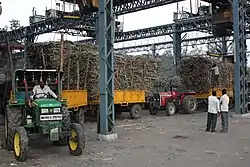
.jpg.webp)
Historically, India has classified and tracked its economy and GDP in three sectors: agriculture, industry, and services. Agriculture includes crops, horticulture, milk and animal husbandry, aquaculture, fishing, sericulture, aviculture, forestry, and related activities.[27][28]
Although Maharashtra is a highly industrialized state of India, agriculture continues to be the main occupation in the state.[10]:18 Since most of the cultivable land is still rain-fed, the Southwest Monsoon season between June and September is critical to the food sufficiency and quality of life in the state. Therefore, the agricultural calendar of Maharashtra and other parts of India is governed by Monsoon. Any fluctuations in the time distribution, spatial distribution or quantity of the monsoon rains may lead to conditions of floods or droughts causing the agricultural sector to adversely suffer. This has a cascading effect on the secondary economic sectors, the overall economy, food inflation and therefore the overall quality and cost of living for the general population. Many areas in Western Maharashtra on the Deccan plateau such as eastern Pune district, Solapur, Sangli, Satara and Ahmadnagar and the Marathwada region are particularly prone to drought. Recent years have seen a huge increase in farmers committing suicide in Maharashtra because of indebtedness resulting from monsoon failure, climate change, and at times cost of growing crops being higher than the market price.[29][30][31][10] The cause for suicide has been linked in some studies to inability to loans mostly taken from banks and NBFCs to purchase expensive seeds and fertilizers, often marketed by foreign MNCs.[32]
Irrigation facilities are being extended so that agriculture could be made less dependent upon rain water. Maharashtra has by far the largest number of Dams in India. Despite that, the net irrigated area totals only 33,500 square kilometres or about 16% of cultivable land.[33]
Principal Monsoon crops include millets such as jwari, Bajri, and Finger millet. These have been grown in the region for thousands of years.[34] In the high rain fall areas of Konkan and the eastern foothills of the Sahyadri mountains, different varieties of rice are cultivated. Other crops include Wheat, pulses, vegetables and onions.
The main Cash crops include cotton, sugarcane, turmeric, and several oil seeds including groundnut, sunflower and soybean. The state has huge areas under fruit cultivation of which mangoes, bananas, grapes, pomegranate and oranges are the main ones.
Maharashtra was a pioneer in the development of Agricultural Cooperative Societies after independence. In fact, it was an integral part of the then Governing Congress party's vision of 'rural development with local initiative'. A 'special' status was accorded to the sugar cooperatives and the government assumed the role of a mentor by acting as a stakeholder, guarantor and regulator,[35][36][37] Cooperatives play a crucial role in dairy,[38] cotton, and fertiliser industries. The members of the respective society include all farmers, small and large, supplying their produce to the processing mill, dairy etc.[39] As with dairy and sugar, cooperatives play a significant part in marketing of fruit and vegetables in Maharashtra. Since the 1980s, the amount of produce handled by Cooperative societies has increased exponentially. Common fruit and vegetables marketed by the societies include products such as bananas, mangoes, grapes, onions and many others.[40] Over the last fifty years, the local sugar mills and other cooperative bodies have played a crucial part in encouraging political participation and as a stepping stone for aspiring politicians.[36]
Maharashtra and Karnataka have been at the forefront of obtaining Geographical indications for a variety of fruit, vegetables, and other crops in the state. Agricultural products on the list from Maharashtra includes Chiku of Gholvad, Nagpur oranges, Nashik grapes, Mahabaleshwar strawberry, Waghya Ghevada (a French bean variety) of Satara district,[41] Jalgaon eggplant, Ambemohar rice etc.,[42][43]
Maharashtra with a coastline of 720 km is one of the leading states in India in marine fish production. Major fish landing centres are New Ferry Wharf, Sassoon Dock and Versova, situated in Mumbai metropolitan area, and they account for nearly 60% of the state fish landings. In year 2017–18, the production was 475,000 metric tons from fish caught in the Arabian sea off coastal Konkan region of the state.[44][45]
Manufacturing Industry
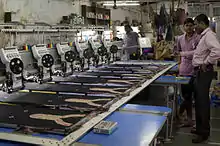
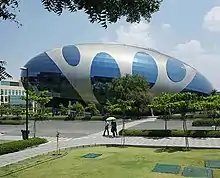
Maharashtra is India's leading industrial state contributing 13% of national industrial output. 64.14% of the people are employed in agriculture and allied activities. Almost 46% of the GSDP is contributed by industry.
Maharashtra has had a long history in textiles with Mumbai being the original home of India's textile mills. Solapur, Ichalkaranji, Malegaon and Bhiwandi are some of the cities known for the textile industry today.
Pharmaceuticals, petrochemicals, heavy chemicals, electronics, automobiles, engineering, food processing, and plastics are some of the major industries in the state. Maharashtra is renowned for the production of three-wheelers, jeeps, commercial vehicles and cars, synthetic fibers, cold rolled products and industrial alcohol. Pune is emerging as one of the largest automobile hubs in the country. Small scale industries have also come up in a big way in the state.
The state capital Mumbai and the Mumbai Metropolitan Region has historically been the most industrialized area in the state. Industrial development in the state is largely concentrated in the Pune Metropolitan Area, Nashik, Aurangabad and Nagpur. The six important industries in the state are cotton textiles, chemicals, machinery, electricals, transport, and metallurgy.[46]
To attract industries to different areas of the state, the government of Maharashtra established Maharashtra Industrial Development Corporation (MIDC) in 1962. MIDC facilitates manufacturing business by creating Special economic zones that hvve infrastructure such as land (open plot or built-up spaces), roads, water supply, drainage facilities, etc.[47][48] To date, 233 areas have been developed around the state with an emphasis on different sectors such as manufacturing, IT, pharmaceutical and wine.
Creative industries
Maharashtra is the leading Indian state for many Creative industries including advertising, architecture, art, crafts, design, fashion, film, music, performing arts, publishing, R&D, software, toys and games, TV and radio, and video games.
Maharashtra is a prominent location for the Indian entertainment industry, with many films, television series, books, and other media being set there.[49] Mumbai is the largest centre for film and television production and a third of all Indian films are produced in the state. Multimillion-dollar Bollywood productions, with the most expensive costing up to ₹1.5 billion (US$21 million), are filmed there.[50] The Marathi film industry, previously located in Kolhapur, has spread throughout Mumbai.
Service Sector
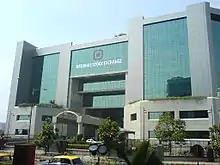
The Service sector dominates the economy of Maharashtra, accounting for 61.4% of the value addition and 69.3% of the value of output in the state.[51] The service sector includes traditional fields such as education, health, transport, real estate, banking and insurance as well as newer sectors such as information technology.
Mumbai, the capital of state and the financial capital of India, houses the corporate headquarters of numerous Indian companies, multinational corporations, and financial institutions. India's main stock exchanges and capital market and commodity exchanges are located in Mumbai. These include the Reserve Bank of India, the Bombay Stock Exchange, the National Stock Exchange of India, the SEBI. The State continues to attract industrial investments from domestic as well as foreign institutions. Share markets in the state transact almost 70 per cent of the country's stocks.[52]
Wholesale and retail trade
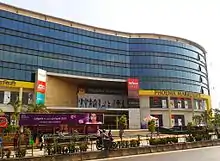
The retail scenario in the state consists of both the organized and the unorganized sectors. The organized sector includes supermarkets, hypermarkets, departmental stores, malls and other privately owned retail chains. The unorganized includes mainly the family owned and operated the local grocery stores, the convenience stores, the vegetable markets, and hawkers.[53] The unorganized sector dominates retail trade and is preferred by the consumers.[54]
Education and Training
The literacy rate in the state was 88.69% in 2011. Of this, male literacy stood at 92.12% and female literacy 75.75%.
- Primary and secondary level
.jpg.webp)
Maharashtra schools are run by the state government or by private organisations, including religious institutions. It is mandatory for local authorities to provide primary education under state law. However, secondary education is an optional duty.[55][56] Public primary schools in the rural and urban are run by the area Zilla Parishad or the municipal corporations respectively. Private schools are run mainly by education trusts and are required to undergo mandatory inspection by the concerned authorities. Private schools are eligible for financial aid from the state government.[57]
The secondary schools are affiliated with the Council for the Indian School Certificate Examinations (CISCE), the Central Board for Secondary Education (CBSE), the National Institute of Open School (NIOS) or the Maharashtra State Board of Secondary and Higher Secondary Education. Under the 10+2+3 plan, after completing secondary school, students typically enroll for two years in a junior college, also known as pre-university, or in schools with a higher secondary facility affiliated with the Maharashtra State Board of Secondary and Higher Secondary Education or any central board. Students choose from one of three streams, namely liberal arts, commerce or science. Upon completing the required coursework, students may enroll in general or professional degree programs. Instruction in schools is mainly in Marathi, English or Hindi, though instruction in other languages such as Urdu, Gujarati or Kannada is also offered if there is sufficient local demand.[58][59][60] Private schools vary in their choice of curriculum and may follow the State Board or one of the two central boards of education, the CBSE or CISCE.[61][62]
*Tertiary level
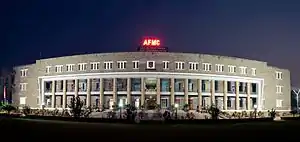
Maharashtra has 24 universities with a turnout of 160,000 Graduates every year.[63][64] The University of Mumbai, is the largest university in the world in terms of the number of graduates and has 141 affiliated colleges.[65] According to prominent national rankings, many Maharashtra colleges and universities are ranked among highest in India.>[66][67] Maharashtra is also home many autonomous institutes as Indian Institute of Technology Bombay.[68] Most of these autonomous institutes are ranked the highest in India and have very competitive entry requirements. Pune has historically been known as a center for higher education and has been referred to as the educational capital of India. In 2006, it was reported that nearly 200,000 students from across India study in Pune at nine universities and more than a hundred educational institutes.[69][70] The state has hundreds of other private colleges and universities, including many religious and special-purpose institutions. Most of the private colleges were set up in the last thirty years after the State Government of Vasantdada Patil liberalised the Education Sector in 1982.[71] Although private, the government plays a regulatory role in the operations of these colleges. Politicians and leaders involved in the huge cooperative movement in Maharashtra were instrumental in setting up many private institutes[72][73] The growth of IT clusters in the state has led to a corresponding increase in setting up engineering colleges to cater for the demand for skilled labor in areas where the clusters are located such as Pune.[74]

The state also has four agricultural universities located in different regions of state.[75] There are also many regional universities that higher education needs at the district levels of the state. Apart from this, there are a number of deemed universities in the state.[76] There are also local community colleges with generally more open admission policies, shorter academic programs, and lower tuition.
*Vocational training
There are a total of 416 ITIs and 310 ITCs with an intake of approximately 1,50,000 (113644 in ITIs and 35512 in ITCs) students. The state has 416 post-secondary school industrial training institutes (ITIs) run by the government and 310 Industrial Training Centres (ITC) run by private entities that offer vocational training in numerous trades such as construction, plumbing, welding, automobile mechanic etc. Successful candidates receive the National Trade Certificate.[77] In 2012 approximately 1,50,000 (113644 in ITIs and 35512 in ITCs) students were enrolled in programs run by these organizations.[78]
Transport
*Road Transport
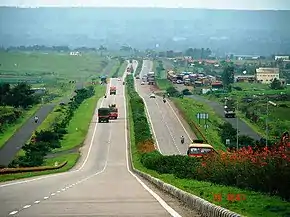
The state has a large, multi-modal transportation system with the largest road network in India.[79] In 2011, the total length of surface road in Maharashtra was 267,452 km;[80] national highways comprised 4,176 km[81] and state highways 3,700 km.[80] Other district roads and village roads provide villages accessibility to meet their social needs as well as the means to transport agricultural produce from villages to nearby markets. Major district roads provide a secondary function of linking between main roads and rural roads. Almost 98% of villages are connected via the highways and modern roads in Maharashtra. Average speed on state highways varies between 50–60 km/h (31–37 mi/h) due to heavy presence of vehicles; in villages and towns, speeds are as low as 25–30 km/h (15–18 mi/h).[82] The national highways get funding from the central government, however, state highways and local roads rely on the state government. Lack of funding has led Maharashtra government to rely on the private sector to fund state highways.[83]
The Maharashtra State Road Transport Corporation (MSRTC) provides economical and reliable passenger road transport service in the public sector.[84] These buses, popularly called ST (State Transport), are the preferred mode of transport for much of the populace. Hired forms of transport include metered taxis and auto rickshaws, which often ply specific routes in cities.
*Railways

Indian government owned Indian Railways runs Rail network in Maharashtra as well as the rest of the country. The state is well-connected to other parts of the country with a railway network spanning 5,983 km between four Railways.[85][86]
- The Central Railway and the Western Railway zones of the Indian Railways that are headquartered in Mumbai, at Chhatrapati Shivaji Terminus and Churchgate respectively,
- The Nagpur Junction has the division, Nagpur (Central) & Nagpur (South East Central) of Central Railway & South East Central Railway respectively.
- The Nanded division of the South Central Railway that caters to the Marathwada region of Maharashtra and
- The Konkan Railway, a subsidiary of the Indian Railways based in CBD Belapur, Navi Mumbai that serves the Konkan coastal region of Maharashtra and continues down the west coast of India.
The rail network is used for carrying freight and people but a greater percentage of freight is carried by trucks than by rail.
*Passenger rail
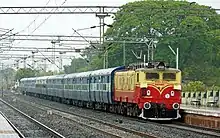
There are multiple train services that connect major cities of India to cities in Maharashtra, for example, the Mumbai Rajdhani Express, the fastest rajdhani train, connects the Indian capital of New Delhi to Mumbai.[87] There are also many services that connect cities within Maharashtra such as the Deccan Queen connecting Mumbai with Pune. The Maharashtra Express service which connects the city of Kolhapur in southwestern Maharashtra to Gondia in Northeast Maharashtra holds the current record for the longest distance covered in one state as its entire run of 1,346 km (836 mi) is entirely within Maharashtra. Thane and CST are the busiest railway stations in India,[88] the latter serving as a terminal for both long-distance trains and commuter trains of the Mumbai Suburban Railway.
Maharashtra also has suburban railway networks in Mumbai and Pune that carry around 6.4 million passengers every day using the same tracks that are used by long-distance passenger and freight trains.[89]
- Sea ports
The two principal sea ports, Mumbai Port and JNP (also called Nhava Sheva), which is also in the Mumbai region, are under the control and supervision of the government of India.[90] JNP accounts for more than half of total container volumes handled at India's 12 public ports and around 40 percent of the nation's overall containerized ocean trade.[91] There are around 48 minor ports in Maharashtra.[92] Most of these handle passenger traffic and have a limited capacity. None of the major rivers in Maharashtra are navigable and so river transport does not exist in the state.
- Air transport
Almost all the major cities of Maharashtra have airports. CSIA (formerly Bombay International Airport) and Juhu Airport are the two airports in Mumbai. The two other international airports are Pune International Airport and Dr. Babasaheb Ambedkar International Airport (Nagpur). While Aurangabad Airport is a domestic airport operated by Airports Authority of India. Flights are operated by both private and government airline companies. Nashik Airport is also a major airport. Most of the State's airfields are operated by the Airports Authority of India (AAI) while Reliance Airport Developers (RADPL), currently operate five non-metro airports at Latur, Nanded, Baramati, Osmanabad and Yavatmal on a 95-year lease.[93] The Maharashtra Airport Development Company (MADC) was set up in 2002 to take up development of airports in the state that are not under the AAI or the Maharashtra Industrial Development Corporation (MIDC). MADC is playing the lead role in the planning and implementation of the Multi-modal International Cargo Hub and Airport at Nagpur (MIHAN) project.[94] Additional smaller airports include Akola, Amravati, Chandrapur, Dhule, Gondia, Jalgaon, Karad, Kolhapur, Nashik Road, Ratnagiri, and Solapur.[95]
Tourism
Tourism is a major industry in Maharashtra with areas around Aurangabad, Mumbai, Pune being the most popular. Places of interest include ancient caves and monuments at Ajanta, Ellora, Elephanta and Karle-Bhaje, numerous mountain forts from the Maratha empire era such as Raigad, Sinhagad, Rajgad, Shivneri, Panhala, British era hill stations such as Lonavala, Khandala, Mahabaleshwar, and Matheran, tiger reserves such as Melghat, Nagzira, and Tadoba, and national parks such as Navegaon Bandh.
Religious tourism includes places such as Shirdi (Saibaba temple), Nashik (Hindu holy place), Nanded (Gurdwara), Nagpur (Dikshabhomi), Siddhivinayak temple and Haji Ali Dargah in Mumbai and Pandharpur (Vitthal-Rukmini temple) as well as the five Jyotirlingas out of eleven and Shakti peethas such as Kolhapur (Mahalakshmi Temple).
Numerous beaches, adventure tourism sites, amusement parks, and water parks also add to the tourism in the state.[96]
Economy of different regions
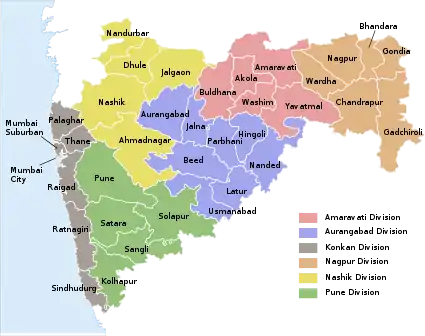
Maharashtra is divided into six divisions for administrative purposes viz. Amravati, Nagpur, Aurangabad, Konkan, Nashik, and Pune. These divisions broadly coincide with Vidarbha (Amravati & Nagpur divisions), Marathwada (Aurangabad), Western Maharashtra (Pune and Nashik divisions), Konkan (Excluding Mumbai Metropolitan region), and Mumbai Metropolitan region. Mumbai metropolitan region and Western Maharashtra are economically the most developed regions and account for the greatest proportion of the states GDP. The Marathwada region is the least developed region mainly because it previously belonged to the princely state of Hyderabad.
*Mumbai Metropolitan area
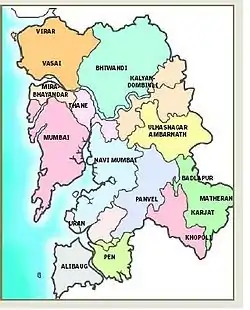
Mumbai is India's largest city (by population) and is the financial and commercial capital of India as it generates 6.16% of the total GDP.[97][98][99] It serves as an economic hub of India, contributing 10% of factory employment, 25% of industrial output, 33% of income tax collections, 60% of customs duty collections, 20% of central excise tax collections, 40% of India's foreign trade and ₹4,000 crore (US$560 million) in corporate taxes.[100] Along with the rest of India, Mumbai has witnessed an economic boom since the liberalisation of 1991, the finance boom in the mid-nineties and the IT, export, services and outsourcing boom in the 2000s.[101] Although Mumbai had prominently figured as the hub of economic activity of India in the 1990s, the Mumbai Metropolitan Region is presently witnessing a reduction in its contribution to India's GDP.[102]
As of 2015, Mumbai's metro area GDP (PPP) was estimated at $368 billion.[103] Many of India's numerous conglomerates (including Larsen & Toubro, State Bank of India (SBI), Life Insurance Corporation of India (LIC), Tata Group, Godrej and Reliance),[98] and five of the Fortune Global 500 companies are based in Mumbai.[104] This is facilitated by the presence of the Reserve Bank of India (RBI), the Bombay Stock Exchange (BSE), the National Stock Exchange of India (NSE), and financial sector regulators such as the Securities and Exchange Board of India (SEBI).[102]
Until the 1970s, Mumbai owed its prosperity largely to textile mills and the seaport, but the local economy has since then diversified to include finance, engineering, diamond-polishing, healthcare and information technology.[105] The key sectors contributing to the city's economy are: finance, gems & jewellery, leather processing, IT and ITES, textiles, and entertainment. Nariman Point and Bandra Kurla Complex (BKC) are Mumbai's major financial centres.[102] Despite competition from Bangalore, Hyderabad and Pune, Mumbai has carved a niche for itself in the information technology industry. The Santacruz Electronic Export Processing Zone (SEEPZ) and the International Infotech Park (Navi Mumbai) offer excellent facilities to IT companies.[106]
State and central government employees make up a large percentage of the city's workforce. Mumbai also has a large unskilled and semi-skilled self-employed population, who primarily earn their livelihood as hawkers, taxi drivers, mechanics and other such blue collar professions. The port and shipping industry is well established, with Mumbai Port being one of the oldest and most significant ports in India.[107] Dharavi, in central Mumbai, has an increasingly large recycling industry, processing recyclable waste from other parts of the city; the district has an estimated 15,000 single-room factories.[108]
Mumbai has been ranked sixth among top ten global cities on the billionaire count with 28[109] and 46000 millionaires, with total wealth around $820 billion[110] 48th on the Worldwide Centres of Commerce Index 2008,[111] seventh in the list of "Top Ten Cities for Billionaires" by Forbes magazine (April 2008),[112] and first in terms of those billionaires' average wealth.[113] As of 2008, the Globalization and World Cities Study Group (GaWC) has ranked Mumbai as an "Alpha world city", third in its categories of Global cities.[114] Mumbai is the third most expensive office market in the world, and was ranked among the fastest cities in the country for business startup in 2009.[115]
*Pune Division *Pune metropolitan region
As one of the largest cities of India and major centre of learning with several colleges and universities, Pune has emerged as a prominent location for IT and manufacturing. Pune has the eighth largest metropolitan economy [116] and the sixth highest per capita income in the country.[117]
Automotive companies such as Bajaj Auto, Tata Motors, Mahindra & Mahindra, Mercedes Benz, Force Motors (Firodia-Group), Kinetic Motors, General Motors, Land Rover, Jaguar, Renault, Volkswagen, and Fiat have set up greenfield facilities near Pune, leading The Independent to cite Pune as India's "Motor City".[118]
The Kirloskar Group, was the first to bring industry to Pune by setting up Kirloskar Oil Engines Ltd. in 1945 at Kirkee in Pune. The Group was originally set up in Kirloskarwadi.[119] Kirloskar Brothers Limited (One of India's largest manufacturer and exporter of pumps and the largest infrastructure pumping project contractor in Asia[120][121]), Kirloskar Oil Engines (India's largest diesel engine company[122]), Kirloskar Pneumatics Co. Ltd., and other Kirloskar companies are based in Pune.
The Hinjawadi IT Park (officially called the Rajeev Gandhi IT Park) is a project started by MIDC to house the IT sector in Pune. When completed, the Hinjawadi IT Park is expected to encompass an area of about 2,800 acres (11 km2). The estimated investment in the project is ₹600 billion (US$8.4 billion).[123] To facilitate economic growth, the government made liberal incentives in its IT and ITES Policy, 2003 and leased properties on MIDC land.[124] The IT sector employs more than 4 lakh people. Software giant Microsoft intends to set up a ₹7 billion (US$98 million) project in Hinjawadi.[124]

Pune Food Cluster development project is an initiative funded by the World Bank. It is being implemented with the help of SIDBI, Cluster Craft to facilitate the development of the fruit and vegetable processing industries in and around Pune.[125][126]
Pune has also emerged as a new startup hub in India with tech startups like Pubmatic, Firstcry.com, Storypick.com, TripHobo,[127] TastyKhana.com (acquired by Foodpanda),[128] Swipe setting up base in Pune.[129] NASSCOM in association with MIDC have started a co-working space for city based startups under its '10,000 startup' initiative at Kharadi MIDC.[130] It will incubate startup such as Kandawale from OhMyDealer in first batch.
The Meetings, Incentives, Conferencing, Exhibitions trade is expected to get a boost once the Pune International Exhibition and Convention Centre (PIECC) completes in 2017. The 97-hectare PIECC will boast a seating capacity of 20,000 with a floor area of 13,000 m2 (139,931 sq ft). It will have seven exhibition centres, a convention centre, a golf course, a five-star hotel, a business complex, shopping malls, and residences. The US$115 million project is developed by the Pimpri-Chinchwad New Town Development Authority.[131] Nowadays a growing number of automotive dealerships are springing up all over the city. They include luxury car makers like Jaguar Land Rover, Mercedes Benz, BMW, Audi, and motorcycle manufacturers like Kawasaki, KTM, Benelli, Ducati, BMW and Harley Davidson.
*Vidarbha

Vidarbha's economy is primarily agricultural, with the addition of forest and mineral wealth. An international cargo hub project, the Multi-modal International Cargo Hub and Airport at Nagpur, (MIHAN), has been developed.[132][133] MIHAN will be used for handling heavy cargo coming from South-East Asia and Middle-East Asia. The project will also include a ₹100 billion (US$1.4 billion) Special Economic Zone (SEZ)[134] for information-technology companies. This will be India's biggest development project.[135]
Gondia, Yavatmal, Chandrapur, Akola, Amravati and Nagpur are the major cities of the region. Nagpur is a central hub for business and healthcare. Nagpur is the winter capital, a sprawling metropolis and the third largest city of the state after Mumbai and Pune. Nagpur is also called Orange city for the huge orange producing area surrounding the city. It also has the largest timber market of Asia. Amravati is known for film distributors and cloth markets. Chandrapur has a thermal power station which is one of the biggest in India and some other heavy industries such as paper (BILT Ballarpur), steel (MEL from Steel Authority of India, etc.), cement (UltraTech Cement, Ambuja Cements, ACC Limited, Manikgarh Cement, Murli Cement) industries and numerous coal mines.[136]
*Nashik Division
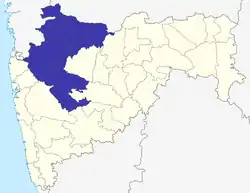
Nashik is one of the fast-growing cities of India[137] and has been included in Smart city project by Central Government of India[138][139] along with The Igatpuri-Nashik-Sinnar investment region[140] as an important node in the US$90 billion Delhi Mumbai Industrial Corridor Project.[141][142] Economy of the city is mainly driven by manufacturing and engineering industry and highly progressive agriculture in the areas surrounding the Nashik city.[143] Many Large scale industry giants have their manufacturing plants and units in the city with presence of companies such as Atlas Copco, Robert Bosch GmbH, CEAT Limited, Crompton Greaves, Graphite India, Schneider Electric, ThyssenKrupp, Epcos, Everest Industries, Gabriel India, GlaxoSmithKline, Hindustan Coca-Cola, Hindustan Unilever Limited, Jindal Polyester, Jyoti Structures, Kirloskar Oil Engines, KSB Pumps, Larsen & Toubro, Mahindra and Mahindra, Mahindra Sona, United Spirits Limited, Perfect Circle Industries, Mahindra Ugine Steel, Samsonite, Shalimar Paints, Siemens, VIP Industries, Indian Oil Corporation, XLO India Limited and Jindal Saw.
Apart from manufacturing, Nashik is also emerging as an investment destination for Information Technology companies. Tata Consultancy Services has invested in Nashik under the Government of India BPO promotion scheme (IBPS).[144] Also, WNS, ACRES, Accenture, ICOMET technologies TCS has set up Digital Impact Square, or DISQ,[145] which is a social innovation center.
Nashik has a textile industry. National Bank for Agriculture and Rural Development[146] has selected Yeola Block for development of Paithani Cluster.[147] To facilitate exports, a container freight station was started at MIDC Ambad by the Central Government. The city also have pharmaceutical industry with presence of Mylan,[148] Holden,[149] fem and Glaxo Smith Kline. There are main five industrial zones under Maharashtra Industrial Development Corporation (MIDC)[150] in the city which are Satpur, Ambad, Sinnar, Igatpuri, Dindori, and Vinchur. The proposed additional areas are Sinnar, Malegaon and Rajur Bahula. Lately, Nasik has emerged as Wine Capital of India[151] with 45 local wineries and vineyards lead by brands such as Sula Vineyards[152][153], Yorkwinery,[154] Zampa[155] and Soma which have international recognition as Nashik Valley wines[156] these vineyards are also developing the tourism related to wine testing and vineyards.Nashik is also known as a main exporter of pomegranates, grapes[157] and onions.[158]
Nashik is a defense and aerospace manufacturing hub with Hindustan Aeronautics Limited aircraft manufacturing plant and DRDO located at Ozar.[159] Artillery Centre in Nashik is the biggest in Asia[160] Nashik is also among the two cities selected by the Central Government for establishing defence innovation centre[161] other being in Coimbatore. The city is also home to The Currency Note Press[162] and India Security Press, where Indian currency and government stamp papers are printed respectively.[163][164]
*Marathwada
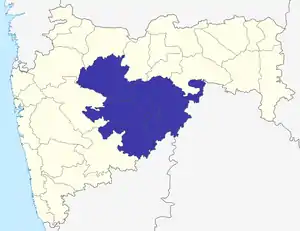
Marathwada has historically known for its poverty, droughts and agricultural backwardness. The word "Marathwada" has been used since the times of the Nizams. The region coincides with the Aurangabad Division of Maharashtra. It borders the states of Karnataka and Telangana, and it lies to the west of the Vidarbha and east of Khandesh regions of Maharashtra. The largest city of Marathwada is Aurangabad. Its people speak Marathi and Dakhini.
- Aurangabad City area
The city was a major silk and cotton textile production centre. A fine blend of silk with locally grown cotton was developed as Himroo textile. Much of the silk industry has vanished over time, but some manufacturers have managed to keep the tradition alive. Paithani silk saris are also made in Aurangabad. The name of this cloth is derived from Paithan town. In 1889 a cotton-spinning and weaving mill was erected in Aurangabad city, which employed 700 people. With the opening of the Hyderabad-Godavari Valley Railways in the year 1900 several ginning factories were started. In the Jalna alone there were 9 cotton-ginning factories and 5 cotton-presses, besides two ginning factories at Aurangabad and Kannad, and one oil- press at Aurangabad. The total number of people employed in the cotton-presses and ginning factories in the year 1901 was 1,016. [1] Until 1960, Aurangabad languished as a city, remaining industrially backward. In 1960, the region of Marathwada was merged with Maharashtra. The industrial development of the Marathwada region began, propelled through designated backward area benefits. Growth began when the Maharashtra Industrial Development Corporation (MIDC) began acquiring land and setting up industrial estates. Aurangabad is a now-classic example of efforts of a state government towards the balanced industrialization of the state. [2] Major Industrial areas of Aurangabad are Chikhalthana MIDC, Shendra MIDC, and Waluj MIDC. GDP ($US) : 840 million
See also
Bibliography
- Sharma, Pradeep (2007). Human Geography: Energy Resources. New Delhi: Discovery Publishing House. ISBN 978-8183562867.
- "India's major ports see 6.7 percent growth in container volumes". JOC.com. 7 April 2015. Retrieved 27 June 2015.</ref>{
References
- "Information About Maharashtra, Industries, Economy, Exports of Maharashtra". ibef.org. Archived from the original on 3 May 2011. Retrieved 12 April 2014.
- SUDALAIMUTHU, S.; RAJ, S.A. (2009). Logistics Management for International Business: Text and Cases. PHI Learning. ISBN 9788120337923. Archived from the original on 14 May 2019. Retrieved 15 March 2018.
- "Information about Maharashtra: Industries, Exports, Economy & Infrastructure Growth". IBEF(Indian Brand Equity Foundation). Retrieved 17 November 2020.
- "Maharashtra Budget Analysis 2020-21". PRS Legislative Research. Retrieved 25 March 2020.
- "SDGs India Index". NITI Aayog. 31 December 2019.
- "Maharashtra Budget Analysis 2016-17" (PDF). PRS Legislative Research. Archived (PDF) from the original on 13 December 2016. Retrieved 19 November 2016.
- "Unemployment Rate in India". Centre for Monitoring Indian Economy. Retrieved 3 November 2020.
- "Archived copy" (PDF). Archived (PDF) from the original on 16 August 2017. Retrieved 16 August 2017.CS1 maint: archived copy as title (link)
- "Archived copy" (PDF). Archived (PDF) from the original on 16 August 2010. Retrieved 27 July 2010.CS1 maint: archived copy as title (link)
- S.S. Kalamkar (14 September 2011). Agricultural Growth and Productivity in Maharashtra: Trends and Determinants. Allied Publishers. pp. 18, 39, 64, 73. ISBN 978-81-8424-692-6.
- http://oar.icrisat.org/10872/1/A%20Better%20World%20-%20Volume%204.pdf
- "Identification of suitable sites for Jatropha plantation in Maharashtra using remote sensing and GIS". University of Pune. Archived from the original on 27 March 2008. Retrieved 15 November 2006.
- "A model Indian village- Ralegaon Siddhi". Archived from the original on 11 October 2006. Retrieved 30 October 2006.
- "Maharashtra economy soars to $85b by 2005". Archived from the original on 14 December 2010. Retrieved 27 July 2010.
- "Maharashtra used up 1193 MW more power in wintert". The Times of India. The Times Group. 22 February 2012. Archived from the original on 15 November 2015. Retrieved 13 September 2014.
- "Indian Power Sector". indianpowersector.com/. Ministry of Power. Archived from the original on 22 August 2014. Retrieved 29 August 2014.
- "Electricity Governance Initiative" (PDF). electricitygovernance.wri.org/. Government of Maharashtra. Archived (PDF) from the original on 3 September 2014. Retrieved 29 August 2014.
- Hiro, Dilip (2015). The Age of Aspiration: Power, Wealth, and Conflict in Globalizing India. New Press. p. 182. ISBN 9781620971413.
- D. S. Chauhan (2006). Non-Conventional Energy Resources. New Age International. pp. 2, 9. ISBN 978-81-224-1768-5.
- "ONGC makes significant oil, gas discovery in Arabian Sea - Times of India". Archived from the original on 28 July 2019. Retrieved 16 July 2019.
- Rao, R.P., and Talukdar, S.N., Petroleum Geology of Bombay High Field - India, in Giant Oil and Gas Fields of the Decade:1968-1978, Halbouty, M.T., editor, AAPG Memoir 30, 1980, Tulsa: American Association of Petroleum Geologists, ISBN 0891813063, p. 504
- Rao, R.P., and Talukdar, S.N., Petroleum Geology of Bombay High Field, India, in Giant Oil and Gas Fields of the Decade:1968-1978, Halbouty, M.T., editor, AAPG Memoir 30, 1980, Tulsa: American Association of Petroleum Geologists, ISBN 0891813063, p. 487
- "Electricity tariff in Maharashtra" (PDF). mercindia.org.in/. Maharashtra State Electricity Board. Archived from the original (PDF) on 12 April 2015. Retrieved 13 September 2014.
- "Maharashtra State Power Generation Company -A Power Generating Utility". mahagenco.in/. Maharashtra State Power Generation Company. Archived from the original on 21 September 2014. Retrieved 13 September 2014.
- "Power demand-supply position of the state of Maharashtra". Green guide. 27 November 2012. Archived from the original on 31 March 2014. Retrieved 17 May 2014.
- Kasisomayajula, S.R., 2013. Compressive study on importance of wind power in India. American Journal of Engineering Research, 2(03), pp.27-35. Archived 22 December 2018 at the Wayback Machine
- Indian Economy Archived 5 July 2014 at the Wayback Machine Government of India (2013)
- Employment across various sectors Archived 23 November 2018 at the Wayback Machine, NSSO 66th Nationwide Survey, Planning Commission, Government of India (3 June 2014)
- Hardikar, Jaideep (21 June 2017). "With No Water and Many Loans, Farmers' Deaths Are Rising in Tamil Nadu". The Wire. Archived from the original on 21 June 2017. Retrieved 21 June 2017.
- Vidhi, Doshi Archived 4 April 2019 at the Wayback Machine The Washington Post: "59,000 farmer suicides in India over 30 years may be linked to climate change, study says", 1 August 2017. Retrieved 13 September 2017.
- 'Sawant, Sanjay Archived 16 July 2019 at the Wayback Machine 'First Post: "Maharashtra Assembly: Over 23,000 farmer suicides have taken place since 2009, says Devendra Fadnavis", 16 March 2017. Retrieved 13 September 2017.
- "In 80% farmer-suicides due to debt, loans from banks, not moneylenders". The Indian Express. Archived from the original on 25 March 2019. Retrieved 25 March 2019.
- Sengupta, S.K. "NATIONAL REGISTER OF LARGE DAMS – 2009" (PDF). Central Water Commission - An apex organization in water resources development in India. Central water Commission. Archived from the original (PDF) on 21 July 2011. Retrieved 14 January 2015.
- Vinod Chandra Srivastava (2008). History of Agriculture in India, Up to C. 1200 A.D. Concept Publishing Company. pp. 108–109. ISBN 978-81-8069-521-6.
- Lalvani, Mala (2008). "Sugar Co-operatives in Maharashtra: A Political Economy Perspective". The Journal of Development Studies. 44 (10): 1474–1505. doi:10.1080/00220380802265108. S2CID 154425894.
- Patil, Anil (9 July 2007). "Sugar cooperatives on death bed in Maharashtra". Rediff India. Archived from the original on 28 August 2011. Retrieved 27 December 2011.
- Miss Banishree Das; Nirod Kumar Palai & Kumar Das (18 July 2006). "PROBLEMS AND PROSPECTS OF THE COOPERATIVE MOVEMENT IN INDIA UNDER THE GLOBALIZATION REGIME" (PDF). XIV International Economic History Congress, Helsinki 2006, Session 72. Archived (PDF) from the original on 24 September 2015. Retrieved 28 September 2015.
- "Mahanand Dairy". Archived from the original on 24 November 2014. Retrieved 28 September 2014.
- "National Federation of Cooperative Sugar Factories Limited". Coopsugar.org. Archived from the original on 5 February 2012. Retrieved 27 December 2011.
- K. V. Subrahmanyam; T. M. Gajanana (2000). Cooperative Marketing of Fruits and Vegetables in India. Concept Publishing Company. pp. 45–60. ISBN 978-81-7022-820-2.
- N. Lalitha; Soumya Vinayan (4 January 2019). Regional Products and Rural Livelihoods: A Study on Geographical Indications from India. OUP India. ISBN 978-0-19-909537-7.
- Kishore, K., 2018. Geographical Indications in Horticulture: An Indian perspective.
- N. Lalitha; Soumya Vinayan (4 January 2019). Regional Products and Rural Livelihoods: A Study on Geographical Indications from India. OUP India. pp. 108–. ISBN 978-0-19-909537-7.
- Devi, M.S., Singh, V.V., Xavier, M. and Shenoy, L., 2019. Catch Composition of Trawl landings along Mumbai coast, Maharashtra. Fishery Technology, 56(1), pp.89-92.
- "सागरी मत्स्य उत्पादनात महाराष्ट्र चौथ्या स्थानावर | eSakal".
- Economy of Maharashtra @ webindia.com Archived 9 August 2007 at the Wayback Machine Suni System (P) Ltd. Retrieved 20 June 2007
- Shrinivas Vishnu Khandewale (1989). Industrial Area and Regional Resources: A Case Study of Nagpur Industrial Area. Mittal Publications. pp. 1–4. ISBN 978-81-7099-134-2.
- Sai Balakrishnan (1 November 2019). Shareholder Cities: Land Transformations Along Urban Corridors in India. University of Pennsylvania Press. p. 128. ISBN 978-0-8122-5146-3.
- "Media and Entertainment Industry -Brief Introduction". ibef.org/. India Brand Equity Foundation (IBEF). Archived from the original on 20 September 2014. Retrieved 13 September 2014.
- Richard Corliss (16 September 1996). "Hooray for Bollywood!". Time. Archived from the original on 26 October 2014. Retrieved 3 January 2015.
- "Service sector synopsis on Maharashtra" (PDF). RBI's Regional Office – Mumbai. Reserve Bank of India. Archived from the original (PDF) on 1 February 2014. Retrieved 1 February 2014.
- Pachouly, Manish (9 August 2011). "Taxpayers in Maharashtra". Hindustan Times. HT Media Ltd. Archived from the original on 7 September 2014. Retrieved 7 September 2014.
- Venkatachalam, R. and Madan, A., 2012. A comparative study of customer preferences towards fresh groceries: organized v/s unorganized retailers. IPEDR, 55(38), pp.188-192.
- [Sarwar, S., 2017. Emerging Malls Boom in Maharashtra State. INTERNATIONAL JOURNAL, 2(8)
- "Govt dissolves education board; schools now under Pune Municipal Corporation's wing - Times of India". The Times of India. Archived from the original on 2 February 2019. Retrieved 4 June 2018.
- "Maharashtra Assembly passes bill allowing private companies to open schools in state, sets guidelines". Archived from the original on 2 February 2019. Retrieved 4 June 2018.
- Joshi, R., Regulatory Requirements for Starting a School in Poona. Centre for Civil Society, CCS RESEARCH INTERNSHIP PAPERS 2004 Archived 3 October 2017 at the Wayback Machine
- "PMC schools to run junior colleges from 2018-19 - Times of India". The Times of India. Retrieved 5 June 2018.
- "Free sanitary napkins for girls in civic schools - Times of India". The Times of India. Archived from the original on 2 February 2019. Retrieved 5 June 2018.
- "Zilla Parishad Pune". punezp.org. Archived from the original on 29 May 2018. Retrieved 27 May 2018.
- "CBSE Class XII Results: Pune schools stand tall; Arts students shine again – Pune Mirror -". Pune Mirror. Archived from the original on 27 May 2018. Retrieved 27 May 2018.
- "High 90% scores & full marks in subjects bring cheer to ICSE schools". The Times of India. Archived from the original on 20 June 2018. Retrieved 27 May 2018.
- "State University". University Grants Commission. Archived from the original on 22 April 2014. Retrieved 13 May 2014.
- "Universities of Maharashtra". Education information of India. Archived from the original on 15 September 2013. Retrieved 13 May 2014.
- "Mumbai University Affiliated Colleges". University of Mumbai. Archived from the original on 9 May 2014. Retrieved 13 May 2014.
- "India's Best Universities for 2013". India Today. 12 May 2013. Archived from the original on 18 May 2014. Retrieved 17 May 2014.
- "Top colleges in state". India Today. Archived from the original on 18 May 2014. Retrieved 17 May 2014.
- "List of autonomous institutes in Maharashtra" (PDF). University Grants Commission. Archived from the original (PDF) on 2 January 2013. Retrieved 13 May 2014.
- Kaul, S., 2006. Higher education in India; seizing the opportunity.INDIAN COUNCIL FOR RESEARCH ON INTERNATIONAL ECONOMIC RELATIONS Archived 27 June 2007 at the Wayback Machine
- Top universities of Largest metropolitan economy -Pune, January −31, 2015, AICTE David, 21 August 2013, archived from the original on 3 April 2015, retrieved 31 January 2015
- Bhosale, Jayashree (10 November 2007). "Economic Times: Despite private participation Education lacks quality in Maharashtra". Archived from the original on 10 October 2014. Retrieved 6 October 2014.
- Dahiwale Vol. 30, No. 6 (11 Feb. 1995), pp., S. M. (1995). "Consolidation of Maratha Dominance in Maharashtra". Economic and Political Weekly. 30 (6): 341–342. JSTOR 4402382.CS1 maint: multiple names: authors list (link)
- Baviskar, B. S. (2007). "Cooperatives in Maharashtra: Challenges Ahead". Economic and Political Weekly. 42 (42): 4217–4219. JSTOR 40276570.
- Krishnan, S., 2014. Political Economy of India’s Tertiary Education. Economic & Political Weekly, 49(11), p.63.
- "Welcome to MCAER official website". mcaer.org. Archived from the original on 29 September 2015. Retrieved 28 September 2015.
- "List of Deemed Universities" (PDF). aicte-india.org. All India Council for Technical Education. Archived (PDF) from the original on 19 February 2015. Retrieved 29 August 2014.
- Campbell, James (editor); Melsens, S; Mangaonkar – Vaiude, P; Bertels, Inge (Authors) (2017). Building Histories: the Proceedings of the Fourth Annual Construction History Society Conference. Cambridge UK: The Construction History Society. pp. 27–38. ISBN 978-0-9928751-3-8. Retrieved 3 October 2017.CS1 maint: extra text: authors list (link)
- Mujumdar, M.S.S., 2012. A Study of Significance of Vocationalization of Education and Skill Development in India-with special reference to the State of Maharashtra. Unpublished PhD Thesis). Symbiosis International University, Pune, India. MHRD.(2014). Revised Scheme of Vocationalization of Higher Secondary Education, Department of School Education and Literacy. New Delhi: MHRD. Archived 23 November 2018 at the Wayback Machine page 32
- "Multimodal transportation system in state". Mumbai Metropolitan Region Development Authority. Archived from the original on 3 September 2014. Retrieved 29 August 2014.
- "Public Private Partnerships in India". pppinindia.com/. Ministry of Finance. Archived from the original on 30 August 2014. Retrieved 29 August 2014.
- "List of State-wise National Highways in India". knowindia.gov.in/. Government of India. Archived from the original on 5 September 2014. Retrieved 29 August 2014.
- "Village speed limit in maharashtra". rediff.com/. Rediff News. Archived from the original on 3 September 2014. Retrieved 29 August 2014.
- Singru, N (2007). Profile of the Indian transport sector. Operations Evaluation Department (PDF). Manilla: World Bank. p. 9. Archived (PDF) from the original on 21 December 2011. Retrieved 22 May 2019.
- "The Maharashtra State Road Transport Corporation". msrtc.gov.in/. Government of Maharashtra. Archived from the original on 3 September 2014. Retrieved 29 August 2014.
- "Western Railway in its present form". Indian Railways. Western Railway. Archived from the original on 13 February 2014. Retrieved 13 February 2014.
- "Central Railway's Head Quarter". Central Railway. Archived from the original on 22 February 2014. Retrieved 13 February 2014.
- "Mumbai-New Delhi Rajdhani Express". The Times of India. 20 May 2012. Archived from the original on 3 March 2015. Retrieved 1 February 2014.
- "Thane is busiest railway station in Mumbai". The Times of India. Archived from the original on 31 October 2016. Retrieved 13 September 2016.
- "Maharashtra – Physical Infrastructure, Railways" (PDF). IBEF. November 2011. Archived (PDF) from the original on 17 May 2012. Retrieved 31 March 2012.
- "List of ports in Maharashtra". Regional Port Offices. Maharashtra Maritime Board. Archived from the original on 3 February 2014. Retrieved 1 February 2014.
- "India's major ports see 6.7 percent growth in container volumes". JOC.com. 7 April 2015. Archived from the original on 7 May 2015. Retrieved 27 June 2015.
- "Sea ports of Maharashtra". Geo cities organisation. Archived from the original on 22 February 2014. Retrieved 13 February 2014.
- "Reliance Airport gets five projects on lease". The Times of India. 6 August 2009. Archived from the original on 30 January 2015. Retrieved 19 September 2011.
- "MIDC projects". Maharashtra Airport Development Company. Archived from the original on 26 February 2012. Retrieved 31 March 2012.
- "Statewise airfield list". cad.gujarat.gov.in/. Director Civil Aviation, Government of Gujarat. Archived from the original on 8 February 2013. Retrieved 5 August 2014.
- "Maharashtra Tourism Development Corporation". Archived from the original on 16 August 2017. Retrieved 16 August 2017.
- "Mumbai Urban Infrastructure Project". Mumbai Metropolitan Region Development Authority (MMRDA). Archived from the original on 26 February 2009. Retrieved 18 July 2008.CS1 maint: unfit URL (link)
- Thomas, T. (27 April 2007). "Mumbai a global financial centre? Of course!". New Delhi: Rediff. Archived from the original on 18 November 2008. Retrieved 31 May 2009.
- "GDP growth: Surat fastest, Mumbai largest". The Financial Express. 29 January 2008. Archived from the original on 5 November 2014. Retrieved 5 September 2009.
- Swaminathan & Goyal 2006, p. 51
- Kelsey 2008, p. 208
- Brihanmumbai Municipal Corporation (BMC). "City Development Plan (Economic Profile)" (PDF). Archived (PDF) from the original on 25 November 2013. Retrieved 25 August 2013.
Mumbai, at present, is in reverse gear, as regards the economic growth and quality of life.
- Lewis, Clara. "Delhi, not Mumbai, India's economic capital". The Times of India. Archived from the original on 14 February 2017. Retrieved 24 February 2017.
- "Fortune Global 500". CNN. 21 July 2008. Archived from the original on 9 May 2012. Retrieved 28 April 2009.
- Swaminathan & Goyal 2006, p. 52
- Jadhav, Narendra. "Role of Mumbai in Indian Economy" (PDF). Archived from the original (PDF) on 22 May 2012. Retrieved 25 August 2013.
- "Indian Ports Association, Operational Details". Indian Ports Association. Archived from the original on 10 April 2009. Retrieved 16 April 2009.
- McDougall, Dan (4 March 2007). "Waste not, want not in the £700m slum". The Guardian. UK. Archived from the original on 31 August 2013. Retrieved 29 April 2009.
- "Mumbai sixth among top 10 global cities on billionaire count". The Times of India. 10 May 2013. Archived from the original on 4 August 2014. Retrieved 8 July 2013.
- "Mumbai richest Indian city with total wealth of $820 billion, Delhi comes second: Report". 26 February 2017. Archived from the original on 27 February 2017. Retrieved 27 February 2018.
- "Worldwide Centres of Commerce Index 2008" (PDF). MasterCard. p. 21. Archived (PDF) from the original on 4 May 2012. Retrieved 28 April 2009.
- Vorasarun, Chaniga. "In Pictures: The Top 10 Cities For Billionaires". Forbes. Archived from the original on 22 April 2009. Retrieved 28 April 2009.
- Vorasarun, Chaniga (30 April 2008). "Cities of the Billionaires". Forbes. Archived from the original on 17 April 2009. Retrieved 28 April 2009.
- "The World According to GaWC 2008". Globalization and World Cities Study Group and Network (GaWC). Loughborough University. Archived from the original on 1 March 2009. Retrieved 7 May 2009.
- "Doing Business in India 2009". World Bank. Archived from the original on 18 October 2010. Retrieved 8 June 2010.
- Top universities of Largest metropolitan economy -Pune, January −31, 2015, AICTE David, archived from the original on 3 April 2015, retrieved 26 February 2018
- "Top Ten Wealthiest Towns of India". Maps of India. Archived from the original on 9 March 2012. Retrieved 1 March 2012.
- "The boom is over in Detroit. But now India has its own motor city". The Independent. London. 20 April 2008. Archived from the original on 21 April 2008. Retrieved 22 April 2008.
- "K. K. Swamy appointed MD of Volkswagen India". The Indian Express. Retrieved 14 December 2009.
- "Kirloskar Brothers restructure group". CNBC-TV18. Archived from the original on 6 December 2009. Retrieved 14 December 2009.
- "Pump Industry in India – Overview, Market, Manufacturers, Opportunities". Indian Pumps And Valves. Archived from the original on 13 June 2018. Retrieved 14 November 2017.
- "Kirloskar Oil Engines". India Business Insight. 31 August 2004. Archived from the original on 9 September 2011. Retrieved 14 December 2009.
- "Hinjawadi IT park". The MegaPolis. Archived from the original on 18 March 2009. Retrieved 13 November 2009.
- Bari, Prachi (7 December 2007). "Hinjawadi, the land of opportunity". The Economic times. India. Archived from the original on 9 May 2009. Retrieved 13 November 2009.
- "PuneFoodHub.com – Food Cluster Pune". Archived from the original on 4 September 2009. Retrieved 15 October 2009.
- "PuneFoodHub.com – Project Partners". Archived from the original on 5 September 2009. Retrieved 15 October 2009.
- "Pune Based TripHobo Raises $3 Mln Series B Funding". Archived from the original on 3 January 2016.
- "Food delivery service Foodpanda acquires rival TastyKhana". Archived from the original on 13 November 2015.
- "Startups find Pune a fertile ground". Archived from the original on 24 August 2015.
- "Start-up Warehouses set up in Navi Mumbai and Pune | NASSCOM". www.nasscom.in. Archived from the original on 7 December 2015. Retrieved 4 June 2016.
- "Pune gets green light for massive MICE centre". TTGmice. Archived from the original on 5 June 2013. Retrieved 12 December 2012.
- "Maharashtra Airport Development Company Limited". madcindia.org. Archived from the original on 10 May 2008. Retrieved 14 May 2008.
- "Maharashtra Airport Development Company Limited" (PDF). Press Information Bureau and Ministry of Civil Aviation. Archived (PDF) from the original on 9 September 2018. Retrieved 29 January 2008.
- "Nagpur stakes claim to lead boomtown pack". The Indian Express. Archived from the original on 29 September 2007. Retrieved 2 December 2019.
- "Mihan is biggest development". The Times of India. 22 May 2007. Archived from the original on 14 March 2012. Retrieved 22 May 2007.
- "Nagpur - Growth Nucleus of India - timesofindia-economictimes". The Economic Times. 24 December 2008. Archived from the original on 14 July 2016. Retrieved 29 May 2015.
ET Bureau 24 Dec 2008, 01.29am IST
- "Archived copy". Archived from the original on 25 November 2010. Retrieved 5 February 2019.CS1 maint: archived copy as title (link)
- "Archived copy". Archived from the original on 10 October 2016. Retrieved 5 February 2019.CS1 maint: archived copy as title (link)
- "Archived copy". Archived from the original on 7 February 2019. Retrieved 5 February 2019.CS1 maint: archived copy as title (link)
- "Archived copy". Archived from the original on 19 May 2018. Retrieved 5 February 2019.CS1 maint: archived copy as title (link)
- "Archived copy". Archived from the original on 14 January 2018. Retrieved 5 February 2019.CS1 maint: archived copy as title (link)
- "Magnetic Maharashtra: Delhi-Mumbai industrial corridor to be showcased". The Indian Express. Retrieved 19 May 2018.
- "Archived copy" (PDF). Archived (PDF) from the original on 9 April 2018. Retrieved 5 February 2019.CS1 maint: archived copy as title (link)
- "Archived copy". Archived from the original on 7 February 2019. Retrieved 5 February 2019.CS1 maint: archived copy as title (link)
- "Archived copy". Archived from the original on 7 February 2019. Retrieved 5 February 2019.CS1 maint: archived copy as title (link)
- "Archived copy". Archived from the original on 3 February 2019. Retrieved 5 February 2019.CS1 maint: archived copy as title (link)
- https://economictimes.indiatimes.com/company/paithani-cluster-yeola-private-limited/U74120MH2011PTC221183
- "Archived copy". Archived from the original on 7 February 2019. Retrieved 5 February 2019.CS1 maint: archived copy as title (link)
- "Archived copy". Archived from the original on 19 January 2019. Retrieved 5 February 2019.CS1 maint: archived copy as title (link)
- "Archived copy". Archived from the original on 7 February 2019. Retrieved 5 February 2019.CS1 maint: archived copy as title (link)
- http://www.jamaicaobserver.com/lifestyle/Wines-from-Nashik---the-wine-capital-of-India_19223423.html
- "Archived copy". Archived from the original on 12 February 2019. Retrieved 5 February 2019.CS1 maint: archived copy as title (link)
- Sula Vineyards
- "Archived copy". Archived from the original on 7 February 2019. Retrieved 5 February 2019.CS1 maint: archived copy as title (link)
- "Archived copy". Archived from the original on 25 February 2019. Retrieved 5 February 2019.CS1 maint: archived copy as title (link)
- Nashik valley wine
- "Archived copy". Archived from the original on 7 February 2019. Retrieved 5 February 2019.CS1 maint: archived copy as title (link)
- https://www.thehindubusinessline.com/news/national/Onion-cultivation-on-the-rise-in-some-districts-of-Maharashtra/article20690178.ece
- https://web.archive.org/web/20130323073214/http://hal-india.com/aircraftdivisionnasik.asp
- "Archived copy". Archived from the original on 7 February 2019. Retrieved 5 February 2019.CS1 maint: archived copy as title (link)
- "Archived copy". Archived from the original on 16 April 2019. Retrieved 5 February 2019.CS1 maint: archived copy as title (link)
- "Currency Note Press, Nashik has Highest Ever Monthly Production of 451.5 Million Pieces (MPCS) of Banknotes during January 2013". Press Information Bureau, Government of India
- "Archived copy". Archived from the original on 27 June 2013. Retrieved 5 February 2019.CS1 maint: archived copy as title (link)
- "Archived copy". Archived from the original on 7 February 2019. Retrieved 5 February 2019.CS1 maint: archived copy as title (link)